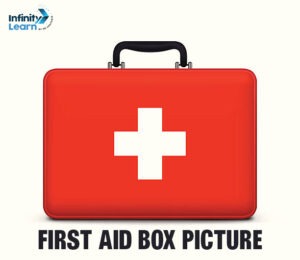Table of Contents
20 First Aid Kit Items: Accidents don’t come with a warning—they can happen anytime, anywhere. Whether you’re at home, traveling, or at the workplace, an emergency can catch you off guard. And in those critical moments, it’s often hard to think clearly or act quickly.
That’s exactly why having a first aid kit nearby is so important. It gives you the tools and confidence to take quick action—whether it’s a minor cut, a burn, or a sudden injury. Quick first aid helps lessen the damage from injuries, stops infections from spreading, and supports faster recovery.
When life takes an unexpected turn, you’ll be glad you planned ahead. A well-stocked and easy-to-access first aid kit can truly make a difference in an emergency. World First Aid Day is also celebrated every year to raise awareness about the importance of learning basic first aid skills and being prepared for emergencies at home, school, or while traveling.
To help you get started, here’s a list of 20 first aid kit items every home, office, and travel bag should have.
What is First Aid?
First aid is the urgent care or simple medical assistance provided right away to someone who gets hurt or falls sick unexpectedly, before experts or doctors can take over. It includes simple actions like cleaning a wound, stopping bleeding, or helping someone who has fainted.
The main goals of first aid are to:
- Save a life
- Prevent the injury or illness from getting worse
- Help the person recover faster
Also Check: Basic First Aid Tips for Students
Why a Waterproof First Aid Kit Container Matters
Before adding supplies, always choose a durable, waterproof box to keep your first aid kit safe and organized
- A damaged, hard-to-carry, or leaky box won’t be useful in an emergency.
- Choose a durable container with a handle for easy transport, and store it in one specific spot at home.
- Make sure all adults know where it is for quick access—but keep it out of reach of young children for safety.
- Proper first aid storage keeps your supplies clean, dry, and ready when you need them most.
First Aid Box Picture

List of 20 First Aid Kit Items and Their Uses
1. Adhesive Bandages (Band-Aids)
These sticky bandages cover small cuts and scrapes. They keep dirt out of wounds and help them heal faster. Keep different sizes in your kit for fingers, knees, and bigger scrapes. Replace your bandage every day to ensure the wound stays clean and heals properly.
2. Gauze Pads
These soft, clean pads soak up blood from bigger cuts. Press them directly on bleeding wounds to stop the flow. You can also wrap them around injuries for protection. Always use clean gauze to avoid infections.
3. Medical Tape
This special sticky tape holds bandages in place without hurting your skin when removed. It works great for wrapping gauze around awkward spots like elbows or knees. The tape comes in different widths for various needs.
4. Antiseptic Wipes
These alcohol or iodine wipes kill germs on cuts and scrapes. Make sure to gently clean any wound first to avoid infection before applying a bandage. The sting you feel means the antiseptic is working to keep harmful bacteria away.
5. Cold Packs
Squeeze these special packs to make them instantly cold—no freezer needed! They reduce pain and swelling from bumps, sprains, and bruises. Cover the cold pack with a soft cloth and place it on the injured area for about 15 minutes.
6. Protective Gloves
These thin gloves create a safety barrier when treating someone else’s wounds. They keep germs from spreading between the injured person and the helper. Always carry several pairs and throw them away after one use.
7. Triangle Bandage
This large triangular cloth makes a quick arm sling for shoulder or arm injuries. You can also fold it to cover large wounds or tie it around limbs to stop bleeding. Every kit needs at least two of these versatile helpers.
8. Tweezers
Use these pinching tools to pull out splinters, small glass pieces, or ticks from skin. Clean tweezers with antiseptic before and after use. Keep a firm grip and gently pull straight to fully remove any foreign objects.
9. Safety Scissors
These special scissors have rounded tips so they won’t poke anyone accidentally. Use them to cut clothing away from wounds or to trim bandages to the right size. They easily cut through fabric, tape, and gauze.
10. Elastic Bandage
This stretchy wrap squeezes gently to support sprained ankles or wrists. Wrap it firmly but not too tight—you should fit two fingers under the bandage.
11. Digital Thermometer
This tool quickly checks body temperature to see if someone has a fever. Modern thermometers beep when they’ve finished measuring and show easy-to-read numbers. If the body temperature rises above 100.4°F (38°C), it’s typically a sign of a fever.”
12. CPR Face Shield
This small plastic barrier goes over a person’s mouth during CPR rescue breathing. It has a one-way valve that lets your breath in but keeps fluids out. This makes helping someone breathe much safer for both people.
13. Emergency Blanket
This thin, shiny silver sheet traps body heat to keep someone warm during shock or cold exposure. Though it looks like foil, it’s incredibly warm and can be lifesaving. It also blocks rain and wind in outdoor emergencies.
14. Pain Relievers
These everyday medicines help relieve pain, bring down fever, and reduce inflammation. Common types include acetaminophen (Tylenol) and ibuprofen (Advil). Always read labels carefully and never give adult doses to children.
15. Antibiotic Ointment
This antiseptic gel helps stop germs from spreading in wounds and protects against infection. It keeps the wound slightly moist to speed healing and reduce scarring.
16. Burn Gel
This special cooling gel soothes and protects minor burns. It pulls heat away from the skin and eases pain quickly. Apply to burns after cooling with water but before bandaging. Never use on severe burns—seek medical help instead.
17. Instant Glucose
These sweet gel packets or tablets quickly raise blood sugar during diabetic emergencies. They work faster than regular candy and can help someone who feels weak, shaky, or confused due to low blood sugar.
18. Saline Solution
This sterile salt water safely rinses debris from eyes, cuts, or scrapes. It doesn’t sting like tap water might. Use it to flush out dirt or chemicals from eyes by gently pouring it across the open eye.
19. Emergency Contact Card
This important card lists phone numbers for poison control, your doctor, and emergency contacts. It should also show important medical information like allergies or conditions. Update this card regularly as information changes.
20. First Aid Guide
This small booklet shows step-by-step instructions for common emergencies. It helps you remember proper first aid steps when stressed. Review this guide before emergencies happen so you’ll feel more confident during a real situation.
First Aid Kit Items You Must Have at Home, School & Travel
20 Essential First Aid Kit Items You Should Always Keep at Home, School, or While Traveling:
| Home | School | Travel |
|---|---|---|
| Adhesive Bandages (various sizes) | Child-friendly Band-Aids | Compact Bandages |
| Sterile Gauze Pads | Small Wound Dressing | Travel-size Gauze Pads |
| Antiseptic Liquid (e.g. Dettol) | Antiseptic Wipes | Antiseptic Spray |
| Digital Thermometer | Contactless Thermometer | Mini Thermometer |
| Pain Relievers (Paracetamol/Ibuprofen) | School-approved Pain Relief (if allowed) | Pain Relievers (tablets or strips) |
| Burn Cream | Aloe Vera Gel | Burn Relief Sachets |
| Crepe Bandage | Light Elastic Bandage | Foldable Crepe Bandage |
| Scissors | Blunt-tip Safety Scissors | Travel-sized Scissors |
| Tweezers | Plastic Tweezers | Metal Tweezers (covered) |
| Ice Pack (Reusable) | Instant Cold Pack | Foldable Gel Cold Pack |
| Gloves (Non-Latex) | Disposable Gloves | Compact Glove Pack |
| CPR Face Mask | CPR Training Mask (if allowed) | Pocket CPR Shield |
| Hydrogen Peroxide / Wound Wash | Saline Solution | Wound Cleanser Wipes |
| First Aid Manual or Instructions | Quick First Aid Guide | Travel Emergency Tips Card |
| Safety Pins | Adhesive Tape | Mini Safety Pins |
| Hydrocortisone Cream | Anti-itch Stick | Itch Relief Wipes |
| Eyewash Bottle | Eye Dropper Solution | Travel-size Eye Drops |
| Medicine List with Emergency Contacts | School Nurse Contact Sheet | Medical Details & Travel Insurance Copy |
| Waterproof Box or Bag | Labeled, child-safe container | Waterproof, zippered pouch |
| Insect Repellent Cream | Mosquito Patch (safe for kids) | Travel-size Repellent Spray |
Summary
- Home kits should be comprehensive for treating cuts, burns, fevers, and minor accidents.
- School kits should be safe, easy to use, and child-friendly with staff access.
- Travel kits should be compact, portable, and suitable for on-the-go emergencies like bug bites, headaches, or wounds.
20 First Aid Kit Items – Golden Rules of First Aid
The “Golden Rules” of first aid focus on staying calm, making sure the area is safe, checking the situation carefully, calling for help quickly, and giving basic care like stopping bleeding and preventing shock.
- Stay Calm First: Panicking won’t help anyone. Take a deep breath and stay as calm as possible so you can think clearly and act wisely.
- Check for Danger: Before helping someone, make sure the area is safe for you and the injured person. Don’t rush into fire, water, or traffic.
- Call for Help: If the injury is serious, call emergency services (like 112 or 911) immediately. Quick professional help saves lives.
- Don’t Move the Injured Person: Unless there’s immediate danger (like fire), don’t move someone who is unconscious or may have a spinal injury.
- Give Only What You Know: Provide only the first aid you’re trained or confident in. Guessing or doing the wrong thing might make things worse.
- Stop the Bleeding: Apply pressure to a wound using a clean cloth or bandage. Controlling bleeding is critical in many injuries.
- Assess breathing and pulse: If the person is not breathing or has no pulse, prepare to give CPR if you know how.
- Keep the Person Warm: Use a blanket or cloth to prevent the injured person from going into shock, especially if they’ve lost a lot of blood.
- Reassure the Injured: Comfort the injured by speaking gently, assuring them that help is coming and they are not alone.
- Always Have a First Aid Kit Ready: Whether at home, school, or traveling — a well-stocked first aid kit can make all the difference in an emergency.
Bonus Tip: Learn basic CPR and first aid techniques from certified organizations. A little training can save a life!
Why Everyone Should Have First Aid Knowledge and a First Aid Kit
Accidents can happen anytime—at home, school, work, or even while traveling. In such moments, knowing basic first aid and having a first aid kit can make a big difference. Here’s why everyone should have it:
- Quick action saves lives
- Helps treat minor injuries on the spot
- Gives time until medical help arrives
- Keeps your family, friends, or coworkers safer
- Essential for travel, outdoor trips, and emergencies
Being prepared with first aid knowledge and the right supplies can give you the confidence to handle emergencies calmly and effectively.
20 First Aid Kit Items FAQs
What is basic first aid?
A basic first aid kit should contain adhesive bandages, gauze pads, adhesive tape, antiseptic wipes, scissors, tweezers, disposable gloves, a CPR face shield, instant cold packs, and a first aid instruction booklet. These essential items help you handle minor injuries and emergencies until professional medical help is available.
What items should be in a 20-item first aid kit?
A comprehensive 20-item first aid kit includes: adhesive bandages, gauze pads, adhesive tape, antiseptic wipes, hydrogen peroxide, antibiotic ointment, scissors, tweezers, disposable gloves, instant cold packs, thermometer, CPR face shield, triangular bandages, elastic bandages, safety pins, emergency blanket, first aid manual, flashlight, pain relievers, and hand sanitizer.
What are the most important medicines to keep in a first aid box?
The most important medicines for a first aid box are: pain relievers (acetaminophen/ibuprofen), antihistamines for allergic reactions, hydrocortisone cream for skin irritations, antibiotic ointment for cuts, calamine lotion for insect bites, antiseptic solution, oral rehydration salts, burn cream, eye wash solution, and cough/cold medicine. Always check expiration dates regularly.
What should be in a first aid kit for 25 people?
A first aid kit for 25 people should contain: 50+ adhesive bandages in various sizes, 20+ gauze pads, 2 rolls of medical tape, 25+ antiseptic wipes, 10+ pairs of disposable gloves, 5+ instant cold packs, trauma scissors, 2 tweezers, digital thermometer, 2+ CPR face shields, emergency blankets, eye wash, multiple elastic bandages, burn treatment supplies, and adequate over-the-counter medications.
What is the difference between a home and workplace first aid kit?
Home first aid kits typically contain basic supplies for family needs, while workplace kits must meet safety regulations and accommodate more people. Workplace kits often include more supplies, specialty items based on specific workplace hazards, and documentation forms for recording incidents. Home kits can be more personalized to family medical needs, while workplace kits should follow OSHA or local workplace safety guidelines.
What is a 10 first aid box?
A 10 first aid box is a small kit with 10 essential first aid box items names with images, perfect for home or travel emergencies. It usually has the basic medicines, bandages, and cleaning supplies.
What should go in a first aid kit for a school?
A school first aid kit must have items like bandages, antiseptic wipes, scissors, gloves, pain relief medicine, ice packs, tweezers, and a first aid guide to handle common injuries.
What medication is used in first aid?
Medications used in first aid include painkillers, antiseptic creams, antihistamines, burn ointments, and sometimes oral rehydration salts for dehydration.









